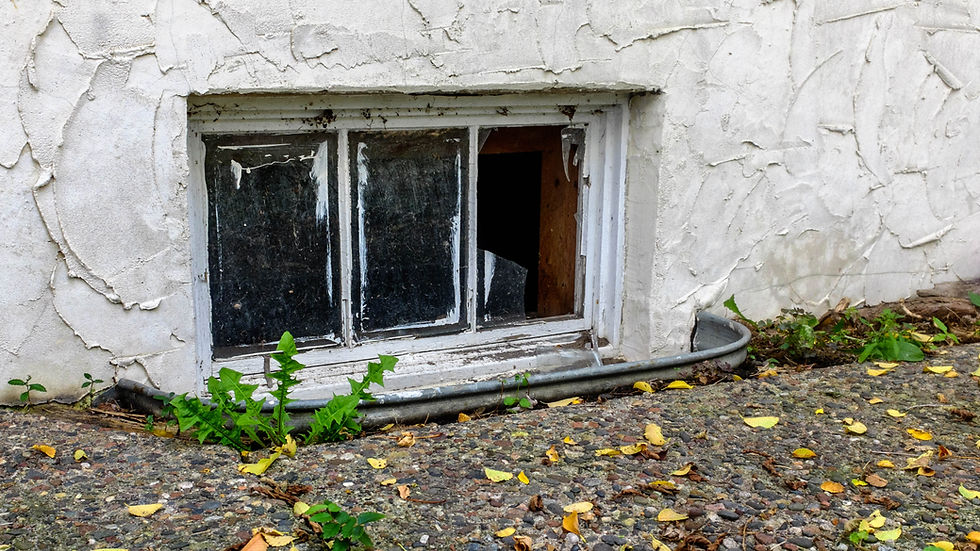The Top Causes of Basement Leaks and How to Stop Them
- Adam Basement

- 6 days ago
- 4 min read
That Dreaded Damp Basement Smell…

You know the one. You walk downstairs and—boom—it hits you. That wet-sock-meets-grandma’s-basement aroma wafts through the air like a warning sign. Ugh. Welcome to leak city.
Hey, Adam Basement here. I’ve seen more soggy boxes, warped paneling, and mildew-sprinkled corners than I care to count. And let me tell you something: basement leaks don’t just make things smell bad—they quietly chew away at your home’s health and value.
The good news? Once you understand what’s causing that sneaky water invasion, you can do something about it. So let’s roll up our sleeves and break it down, one culprit at a time.
Common Causes of Basement Leaks: The Real Troublemakers

Basement water problems are like crime dramas—there’s always a suspect. Sometimes it’s obvious. Other times, it’s hiding behind drywall. But we usually look at three main categories: structural issues, poor drainage, and plumbing failures.
1. Foundation Cracks
You see a tiny hairline crack in the wall and think, “Eh, no big deal.” But water? Water sees that as an open door.
Why it happens:
Your house settles over time
Soil pushes against the foundation
Materials age and break down
How to handle it:
For small cracks, you can use epoxy or polyurethane sealants
Larger cracks? Bring in a pro. Seriously.
And waterproof the exterior if you’re in it for the long haul
2. Poor Exterior Drainage
Ever notice water puddling near the base of your home after a rainstorm? That’s your yard trying to send water straight into your basement.
Red flags:
Gutters overflowing like a broken soda machine
Downspouts that stop inches from your foundation
Your lawn slopes toward your house (whoops)
Your fix-it list:
Add downspout extenders—6 feet or more is ideal
Clean those gutters (yes, really)
Re-grade the soil to slope away from the foundation
3. Hydrostatic Pressure
Fancy term. Big problem. This is the pressure from saturated soil pushing water through your walls and floor.
What it causes:
Cracks in the foundation
Bowing or bulging walls
Recurring wet spots after heavy rain
How to fight back:
Install a French drain or interior drainage system
Add (or upgrade) your sump pump
Waterproof the outside of the foundation with a proper membrane
4. Leaky Basement Windows
Window wells are notorious for collecting leaves, rainwater, and regret.
Check for:
Rusted or clogged wells
Cracked window frames
Missing caulk
Solutions:
Clean out and cover those window wells
Reseal or replace the windows
Install a drain inside the window well if it tends to flood
5. Plumbing Leaks or Appliance Failures
Not all leaks come from outside. Sometimes your plumbing betrays you.
Sneaky culprits include:
Burst washing machine hoses
Leaky water heaters
Pipe joints that finally give out
Your move:
Check and replace old hoses and connectors
Install water alarms (tiny investment, big peace of mind)
Don’t ignore tiny leaks—they usually grow into full-blown disasters
Interior vs. Exterior Fixes: What’s the Best Approach for Basement Leaks?

People often ask me: Should I waterproof from the inside or the outside?
Well, here’s how to stop basement leaks:
Interior Fixes:
More affordable and great for immediate relief
Includes sump pumps, vapor barriers, and interior French drains
Good if you already have water coming in
Exterior Fixes:
More expensive, but highly effective long-term
Stops water before it gets in
Includes excavation, waterproof membranes, and exterior drains
My take? You’ll get the best results when you combine both. Patch and protect from the inside, but don’t skip the exterior armor if you want true peace of mind.
Bonus: Smart Basement Waterproofing Upgrades
Ready to go beyond the basics?
If you're tired of patch jobs and want to sleep soundly during the next downpour, consider these long-term leaking basement solutions:
Battery-backup sump pump: Because leaks don’t take breaks when the power goes out
Interior French drain system: Redirects water like a basement bouncer
High-capacity dehumidifier: Keeps moisture (and mold) in check
Exterior waterproof membrane: Your basement’s personal raincoat
These upgrades are like armor for your basement.
When It’s Time to Call in the Pros For those Basement Leaks

You’ve patched, sealed, and screamed into the void. You’ve tried DIY fixes, and you’re still mopping up puddles or smelling mildew. Well, that’s your sign. Time for a professional assessment.
Here at Adam Basement, we’ve got the tools, team, and know-how to handle leaks of all sizes. Whether it’s a suspicious crack, a sump pump meltdown, or that mystery puddle that appears every time it rains—we’re on it.
Here’s what we offer:
✔️ Inspect your foundation and drainage systems
✔️ Recommend the right blend of interior and exterior solutions
✔️ Handle repairs with high-quality materials and zero guesswork
And yes—we’ll explain everything in plain English. No jargon. No pressure.
Stop the Drip Before It Becomes a Disaster
Let’s face it: basement leaks aren’t cute. They’re silent destroyers that mess with your home’s structure, air quality, and value. But now? You’ve got the upper hand.
You know what causes them, how to fix them, and when to bring in backup. No more guesswork. No more musty smell. No more wet socks.
So… ready to dry things out for good?
Adam Basement is here for it.
Whether it’s a small leak, a major flood, or just a hunch that something’s not right, we’re here to assess, fix, and protect your basement like it’s our own.
No more swamp smells. No more wet socks. Just a dry, safe, worry-free basement.




Comments